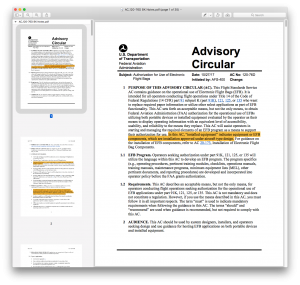
 The transition from paper charts to the iPad and EFBs has been a fairly painless one for GA pilots over the last 7 years thanks to the FAA’s common sense approach to the technology.
The transition from paper charts to the iPad and EFBs has been a fairly painless one for GA pilots over the last 7 years thanks to the FAA’s common sense approach to the technology.
While there are no specific FARs that regulate their use, pilots flying under Part 91 should refer to Advisory Circular 91-78 for guidance on how to incorporate an iPad into normal flight operations to replace paper charts. In summary, there is no FAA approval required and it’s completely up to you as the PIC on how you choose to fly with an EFB.
On the other end of the spectrum, pilots flying in commercial operations (part 121, 135, etc.) must follow the guidance of AC 120-76. This requires operators to develop specific procedures for EFB use, complete interference testing and get FAA approval, among many other requirements.
Last month, the FAA released a new version of this guidance, AC 120-76D, that includes some significant updates. This AC has been updated several times over the past 10 years, and this third revision is the biggest yet – and most practical. The FAA worked closely with industry, other regulatory authorities, and the International Civil Aviation Organization (ICAO) Operations Panel to harmonize EFB guidance. Here are some highlights of what’s new in the latest version.
 Own-ship display in flight – Until now, commercial operators were only allowed to display their aircraft symbol on their EFB’s moving map chart display when taxiing on the ground, and not while in flight. This restriction is no longer in place, provided the following criteria are met:
Own-ship display in flight – Until now, commercial operators were only allowed to display their aircraft symbol on their EFB’s moving map chart display when taxiing on the ground, and not while in flight. This restriction is no longer in place, provided the following criteria are met:
- You can display the aircraft ownship on an EFB in flight provided you have an installed flight display, weather display or map display that also depicts own-ship position. This allows you to quickly resolve a position discrepancy if something doesn’t look right on your EFB.
- It’s recommended that you use a GPS position source installed on the airplane. If this is not available, a portable GPS accessory (like a Stratus or Bad Elf GPS) is recommended over using the EFB’s internal GPS (such as the GPS found on the iPad with the cellular data option).
- You must change the the own-ship to a non-directional (circular) depiction when track or heading is not available. Most apps already do this now.
Updated definition of an Electronic Flight Bag (EFB) – this definition was updated to underscore that a device displaying EFB applications is considered an EFB:
An EFB hosts applications, which are generally replacing conventional paper products and tools, traditionally carried in the pilot’s flight bag. EFB applications include natural extensions of traditional flight bag contents, such as replacing paper copies of weather with access to near-real-time weather information.
Elimination of EFB Classes – There are no longer references to Class 1, 2 or 3 EFBs. Instead, the AC now classifies EFBs as either portable or installed. Furthermore, an EFB is only considered “installed” when it is incorporated into aircraft type design under 14 CFR part 21, or as a proper alteration under 14 CFR part 43. All other EFB types are considered portable. It’s worth pointing out though that portable devices are still authorized to connect to aircraft power for charging, data ports, aircraft antennas, etc., and can be mounted to a fixture attached to the airplane. You just need to be able to remove the EFB from its mount without tools or maintenance action.
Easier EFB Program Management – The new AC authorizes operators to evaluate and incorporate minor modifications to their authorized EFB program without having to contact their FAA principal inspector. Minor program modifications include:
- Adding/updating EFB applications
- Incorporating OS updates (e.g. updating to the latest version of iOS for iPad)
Part 91 operations for aircraft over 12,500 lbs. – Pilots flying under Part 91F (Large and turbine-powered multiengine airplanes) no longer need to follow the guidance of this advisory circular to use an EFB in lieu of paper charts. It still applies to Part 91K though.
It’s worth repeating that while GA pilots flying under Part 91 are not required to follow the requirements of AC 120-76D, you should still give this updated guidance a quick read. It provides some excellent recommendations that pilots of any airplane size should consider incorporating into their day-to-day procedures for flying with an iPad.
Source: Ipad appsNew EFB guidance allows commercial operators to display own-ship on iPad in flight